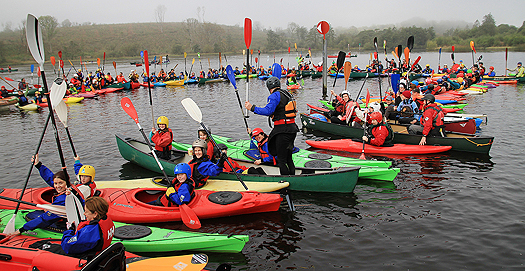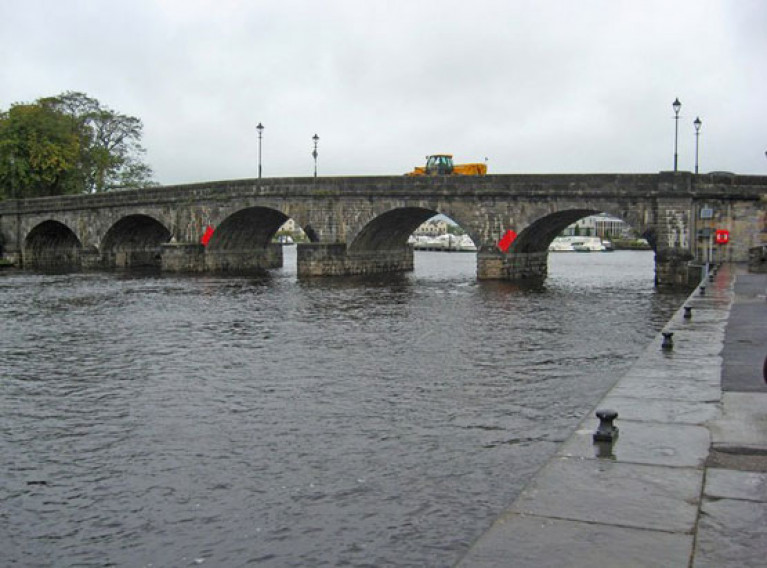Displaying items by tag: Carrick On Shannon
A woman has died after a fire on a boat in Carrick-on-Shannon this morning (Monday 7 August).
RTÉ News reports that emergency services were alerted this morning to the blaze in the popular tourism destination on the Shannon Navigation.
According to the Irish Independent, the deceased was a highly respected female garda who was based in south Dublin.
Waterways Ireland advises all masters on and users of the Shannon Navigation of mooring and navigation restrictions in Carrick-on-Shannon to facilitate the rowing club regatta on Sunday 6 August.
The regatta will be held on a 500-metre stretch of water immediately south of the town bridge commencing at 9am and finishing at around 6pm.
Craft wishing to make a through passage will be facilitated approximately every two hours during the regatta.
Masters should note that only vessels of an overall length of 6.8m (22ft) or less will be permitted on the floating jetties from next Wednesday 2 to Sunday 6 August. This is necessary in the interest of marine safety and to facilitate the laying of the competition course.
Vessels berthed from next Wednesday at 4pm will be required to remain in place until racing finishes on the Sunday, the cross-border body for Ireland’s inland waterways adds.
Masters are advised to proceed at slow speed and with due caution and to take note of advice from course marshals when passing through the area.
Waterways Ireland wishes to advise all masters and users of the Shannon Navigation of navigation and mooring restrictions in Carrick-on-Shannon to facilitate the Carrick Rowing Regatta on Sunday 31 July.
The regatta, hosted by Carrick-on-Shannon Rowing Club, will be held on a 500-metre stretch of water immediately south of the town bridge commencing at 9am and finishing at around 6pm.
Craft wishing to make a through passage will be facilitated approximately every two hours during the course of the regatta.
Only vessels of an overall length of 22ft/6.8m or less are currently permitted on the floating jetties until the completion of the regatta. This is necessary in the interest of marine safety and to facilitate the laying of the competition course.
Vessels berthed from 4pm on Wednesday 27 July will be required to remain in place until racing finishes on Sunday.
Masters are advised to proceed at slow speed and with due caution and to take note of advice from course marshals when passing through the area.
Caution Advised for Boaters Around ‘Head of the Shannon’ Rowing Event
Waterways Ireland wishes to advise all masters of vessels and water users that the Head of the Shannon rowing event will take place on Saturday 4 December.
The event will take place downstream of Carrick-on-Shannon bridge for a distance of 3.5km.
The rowing starts at navigation maker known locally as White Woman/White Lady and will proceed back to the Marina downstream of of the bridge.
Rowing events will take place at 11am and 2pm on the day.
Masters of vessels on the Shannon Navigation are requested to proceed with additional caution in the vicinity of the rowing events.
Boardwalk Upgrade Improves Marina Access on the River Shannon
Leitrim County Council has recently improved shoreside access to its Carrick on Shannon public marina, replacing its existing fixed boardwalk with a new 340m long by 2.4m wide floating walkway.
Working with Deane Public Works, Inland and Coastal Marina Systems (ICMS), designed and manufactured the new installation which includes a 3m wide fuel berth and eight access gangways with lifebuoy housings and safety ladders, all anchored in place by a new piled mooring system.
The heavy-duty pontoon system, topped with ICMS’ unique glass-reinforced concrete (GRC) decking, provides safe and non-slip, all-year-round access to the marina’s on-site facilities for the public and all leisure boat users, which includes local boat hire companies.
“Being a very popular cruising area, it was important that we completed the installation with as minimal disruption as possible to the local access,” says Ger Buckley, project engineer at ICMS. “We achieved this by taking a phased approach, closely liaising with all contractors and programming the activities in.”
Wrapping around the entire length of the marina site, the public boardwalk now connects the quayside to the access road and car park, allowing users to enter the marina via a new gangway on the eastern side, and exit on the northern side.
“We’re delighted with the quality of the new boardwalk, an attractive upgrade to the waterfront providing a strong, stable walkway for visitors,” says Shay O’Connor, senior engineer with Leitrim County Council. “Even though conditions were challenging at times with access routes being periodically submerged, the team at Inland and Coastal completed the installation efficiently and without disrupting the activities of the regular commercial users of the marina.
“The boardwalk will provide a new walking route along the waterfront for both locals and visitors and new access for users of leisure vessels which cruise along this section of the River Shannon, boosting the tourist industry which plays a major role here in Carrick on Shannon’s economy.”
To find out more about Inland and Coastal’s pontoon ranges and unique decking options visit here
Essential Diving Operations in Carrick-on-Shannon
Waterways Ireland advises masters of vessels that essential diving operations will take place on behalf of Leitrim County Council at Carrick-on-Shannon tomorrow, Monday 11 January, from 11am to 2pm.
Following on from dives scheduled for last month, locations of the diving operations are along the quay wall some 30 metres downstream and upstream of the bridge, and along the quay wall near the boat club.
Masters of vessels on the Shannon Navigation and all inland waterways users are requested to proceed with additional caution in the vicinity of these diving operations.
High Water Levels on Shannon Hit Rowing Clubs Hard
Rowing clubs along the Shannon have been badly affected by high water levels. Carrick on Shannon and Athlone have both been hit, while Castleconnell is flooded. This came despite pumping. The gym equipment had been moved out and the boats are stored higher up the bank.
This ESB at Ardnacrusha stated: “Due to heavy rainfall in the catchment we will be increasing discharge from Parteen Weir. You are being notified that water is about to be discharged above 325 m3/sec. This will result in flooding of roads, land and may affect property. You are advised to be aware of increased flows in the river as a result of this water discharge. Further increases in discharge may be required. Approx. 400 m3/sec will be discharged.”
Juniors Shine at Skibbereen and Portadown
Good Day for Shandon and Coláiste Iognáid
#Rowing: The weather held up well for both the Muckross Head of the River and the Head of the Shannon at Carrick on Shannon today.
Shandon’s men’s intermediate eight topped the Muckross provisional rankings at the National Rowing Centre, while their men’s senior quadruple and men’s club eight placed fifth and sixth. UCC’s women’s club eight were the fastest women’s crew.
The Coláiste Iognáid men’s junior 18 eight took the honours at Carrick on Shannon. They competed in the second head, at 2 o’clock, which had the superior weather conditions. Commercial’s men’s senior eight took second.
Shannon Blueway Launched with a Splash in Leitrim
#blueway – Minister Heather Humphreys TD, and actor & producer Carrie Crowley joined with over 300 walkers and paddlers to open the Shannon Blueway today in Drumshanbo, Co Leitrim.
As previously reported on Afloat.ie, the Shannon Blueway runs from Drumshanbo through Battlebridge and Leitrim Village to Carrick on Shannon. It includes 16.5km of water trail and over 10km of walking routes in three loops. The Shannon Blueway provides a range of recreational leisure activities such as walking, cycling, canoeing, fishing and cruising all linked by the waterways to local towns and villages.
Minister Heather Humphrey's stated "I am delighted to be launching this project here in Leitrim today. The Shannon Blueway has the potential to have a very positive impact on jobs and the regional economy. The Mayo Greenway, which is now in its 4th year of operation, has seen a jump in visitor numbers from 80,000 in 2011 to 300,000 in 2014. That means an extra €5 million was brought into the region. With the market for off road adventure tourism is growing here in Ireland and internationally, Leitrim is in a prime position to benefit from this trend.
The launch of the Blueway will allow local businesses can capitalise on an increase in demand for transport, equipment hire, accommodation and entertainment. I would like to commend Waterways Ireland for this initiative, which I have no doubt will have a very position impact on the region."
Carrie Crowley said "as a self-confessed blow-in to the area, the Shannon, the wonderful countryside and Leitrim people have provided me with a tranquil and inspirational place to work and home away from home .The only problem is, now our secret is out!"
The Shannon Blueway is the first of its kind in Ireland where a myriad of recreational activities have been developed and bundled together as a single or multiple visitor experience and tourism proposition. Waterways Ireland has, using the wonderful waterway assets, developed and built a canoe trail from Drumshanbo through Battlebridge and Leitrim Village to Carrick on Shannon. It has also developed a series of looped walks adjacent to the Lough Allen Canal with plans to expand those walks to Drumshanbo and Carrick on Shannon. At the same time Waterways Ireland is also developing a canoe trail from Leitrim Village along the 63km of the Shannon Erne Waterway with a walking and cycling trail also at an advanced stage of planning.
The Shannon Blueway is being delivered by Waterways Ireland in partnership of the National Trails Office, Canoeing Ireland, Leitrim County Council, Leitrim Tourism and Fáilte Ireland.

Minister Heather Humphreys TD, and WI Chief Executive Dawn Livingstone
Chief Executive Dawn Livingstone confirmed that partnership was the key to delivering the Shannon Blueway "Waterways Ireland has invested significantly in creating world beating facilities and services on the Shannon Navigation. Through our partnership with the National Trails Office, Canoeing Ireland, Leitrim Tourism and Leitrim County Council an outstanding multi-activity product has been built in the Shannon Blueway which is now being packaged by clubs and communities for their recreational activities and companies and organisations for domestic and international tourists. Partnership is key to delivering the future of the Shannon Blueway further into Leitrim, and indeed into Roscommon, Longford and Cavan."
The wider Shannon Blueway of which the Drumshanbo to Carrick on Shannon section is part, is at the heart of access to 100km of paddling area, 6 looped walks: 3 of which are on the canal towpath, two long distance walks and three heritage trails. The Shannon Blueway will ultimately provide access to 14 towns and services with each access point and town within an hours' paddling time.

300 paddlers joined the ShannonBlueway launch
Waterways Ireland and Leitrim Co Co will shortly be examining the possibility of providing a connection from the jetties at Acres Lake to the canal towpaths and also to complete the walking/cycling connection to Carrick-on-Shannon, and up the Shannon-Erne Waterway.

































































